A New Approach to Investigate the Spatially Heterogeneous in the Cooling Effects of Landscape Pattern
Abstract
:1. Introduction
2. Research Review
3. Materials and Methods
3.1. Study Area
3.2. Data Source and Preprocessing
3.3. Land Surface Temperature Retrieve and Urban-Heat-Island Ratio Index
3.4. Landscape Classification and Sample Designation
3.5. Calculation of Landscape Pattern Comprehensive Index
3.5.1. Selection of Landscape Pattern Index
3.5.2. Principal Component Analysis
3.6. Geographically Weighted Regression Model
4. Results
4.1. Spatio-Temporal Characteristics of Urban Heat Island
4.2. Cooling Effects of Different Landscape Types
4.3. Spatial Distribution of Landscape Patterns
4.4. Spatial Heterogeneous Cooling Effects of Landscape Pattern
5. Discussion
5.1. Validity Evaluation of LPCI
5.2. The Relationship between Urban Landscape and Thermal Environment
5.3. Implications and Limitations
6. Conclusions
Author Contributions
Funding
Institutional Review Board Statement
Informed Consent Statement
Data Availability Statement
Conflicts of Interest
References
- Wei, H.K.; Li, L.; Nian, M. Strategy and Policy of China’s Urbanization during the 14th Five Year Period. J. Party Sch. Cent. Comm. CPC 2020, 24, 5–21. [Google Scholar] [CrossRef]
- Hou, H.R.; Ding, F.; Li, Q.S. Remote Sensing Analysis of Changes of Urban Thermal Environment of Fuzhou City in China in the Past 20 Years. J. Geo-Inf. Sci. 2018, 20, 385–395. [Google Scholar]
- Chen, Y.H.; Cai, Y.B. The differences of thermal environment effect of urban green space evolution: A case study of Fuzhou. Chin. J. Ecol. 2019, 38, 2149–2158. [Google Scholar]
- Fan, Z.Y.; Zhan, Q.M.; Liu, H.M.; Yang, C.; Xia, Y. Spatial-temporal Distribution of Urban Heat Island and the Heating Effect of Impervious Surface in Summer in Wuhan. J. Geo-Inf. Sci. 2019, 21, 226–235. [Google Scholar]
- Zhang, X.L.; Zhao, P.X.; Gao, L.H.; Zhao, X.; Wang, H. Analysis of Heat Island Effect Based on Landsat Images in Xining City. J. Northwest For. Univ. 2016, 31, 183–190. [Google Scholar]
- Liu, Y.H.; Xu, Y.M.; Ma, J.J.; Quan, W.J. Quantitative Assessment and Planning Simulation of Beijing Urban Heat Island. Ecol. Environ. Sci. 2014, 23, 1156–1163. [Google Scholar]
- Buyantuyev, A.; Wu, J.G. Urban heat islands and landscape heterogeneity: Linking spatiotemporal variations in surface temperatures to land-cover and socioeconomic patterns. Landsc. Ecol. 2010, 25, 17–33. [Google Scholar] [CrossRef]
- Cui, L.L.; Li, G.S.; Ji, D.J. Heat island effect and its relationship with land use in Chengdu City. Chin. J. Ecol. 2013, 37, 1518–1526. [Google Scholar]
- Li, D.; Bou-Zeid, E. Synergistic Interactions between Urban Heat Islands and Heat Waves: The Impact in Cities Is Larger than the Sum of Its Parts. J. Appl. Meteorol. Climatol. 2013, 52, 2051–2064. [Google Scholar] [CrossRef] [Green Version]
- Qiu, X.F.; Gu, L.H.; Zeng, Y.; Jiang, A.J.; He, Y.J. Study on Urban Heat Island Effect of Nanjing. Clim. Environ. Res. 2008, 13, 807–814. [Google Scholar]
- Wang, L.; Xu, H.Q. Thermal Environment Change of Fuzhou City with Rapid Urbanization. J. Tongji Univ. 2017, 45, 1336–1344. [Google Scholar]
- Shou, Y.X.; Zhang, D.L. Recent advances in understanding urban heat island effects with some future prospects. Acta Meteorol. Sin. 2012, 70, 338–353. [Google Scholar]
- Xie, Q.J.; Liu, J.H.; Hu, D.H. Urban expansion and its impact on spatio-temporal variation of urban thermal characteristics: A case study of Wuhan. Geogr. Res. 2016, 35, 1259–1272. [Google Scholar]
- Yao, Y.; Chen, X.; Qian, J. Research progress on the thermal environment of the urban surfaces. Acta Ecol. Sin. 2018, 38, 1134–1147. [Google Scholar]
- Le, T.C.; Nie, S.; Pan, H.; Li, L.C. Land surface temperature retrieval and urban heat island effect based on Landsat 8 image in Fuzhou city. J. Northwest For. Univ. 2019, 34, 154–160. [Google Scholar]
- Li, F.J.; Ma, A.Q.; Ding, Y.D.; Yang, J.J.; Jiao, J.C.; Liu, L.J. Research on Urban Heat Island Effect Based on Landsat Data. Remote Sens. Technol. Appl. 2009, 24, 553–558. [Google Scholar]
- Jimenez-Munoz, J.C.; Sobrino, J.A. A Generalized Single Channel method for retrieving land surface temperature from remote sensing data. J. Geophys. Res. 2003, 108, 4688–4697. [Google Scholar] [CrossRef] [Green Version]
- Qin, Z.; Karnieli, A.; Berliner, P. A Mono-Window Algorithm for Retrieving Land Surface Temperature from Landsat TM Data and Its Application to the Israel Egypt Border Region. Int. J. Remote Sens. 2001, 22, 3719–3746. [Google Scholar] [CrossRef]
- Sobrino, J.A.; Li, Z.L.; Stoll, M.P.; Becker, F. Multi-channel and multi-angle algorithms for estimating sea and land surface temperature with ATSR data. Int. J. Remote Sens. 1996, 17, 2089–2114. [Google Scholar] [CrossRef]
- Tan, Z.H.; Zhang, M.H.; Karnieli, A.; Berliner, P. Mono-window Algorithm for Retrieving Land Surface Temperature from Landsat TM6 data. Acta Geogr. Sin. 2001, 4, 456–466. [Google Scholar]
- Yang, M.; Yang, G.A.; Wang, Y.J.; Zhang, Y.F.; Zhang, Z.H.; Sun, C.H. Remote sensing analysis of temporal-spatial variations of urban heat island effect over Beijing. Remote Sens. Land Resour. 2018, 30, 213–223. [Google Scholar]
- Wang, T.X.; Chen, S.L.; Yan, G.J. Estimation of land surface parameters and spatio-temporal characteristics of urban heat island. Sci. Geogr. Sin. 2009, 29, 697–702. [Google Scholar]
- Su, Y.L.; Zhang, Y.F. Spatio-temporal characteristics of urban heat island effect of Xi′an city based on landsat TM/ETM+. Bull. Soil Water Conserv. 2011, 31, 230–234. [Google Scholar]
- Xu, H.Q.; Chen, B.Q. A study on urban heat island and its spatial relationship with urban expansion: Xiamen, SE, China. Urban Dev. Stud. 2004, 11, 65–70. [Google Scholar]
- Liu, Y.H.; Fang, X.Y.; Zhang, S.; Luan, Q.Z.; Quan, W.J. Research on quantitative evaluations of heat islands for the Beijing-Tianjin-Hebei urban agglomeration. Acta Ecol. Sin. 2017, 37, 5818–5835. [Google Scholar]
- Sun, M.; Xie, M.; Ding, M.H.; Xu, W.L.; Huang, S.Q.; Gao, F. Spatio-temporal variation of urban heat island effects in Fangchenggang City, Guangxi Zhuang Autonomos Region. Remote Sens. Land Resour. 2018, 30, 135–143. [Google Scholar]
- Xue, W.R.; Lu, Z.; Dan, S.Z.; Xu, H.X.; He, Z.W.; Chou, W.X. Evaluation of urban heat island effects in Neijiang City of Sichuan province based on thermal infrared remote sensing. Geomat. Spat. Inf. Technol. 2012, 35, 38–41. [Google Scholar]
- He, J.J.; Yu, Y.; Yu, L.J.; Liu, N.; Zhao, S.P. Impacts of uncertainty in land surface information on simulated surface temperature and precipitation over China. Int. J. Climatol. 2017, 37, 829–847. [Google Scholar] [CrossRef]
- Li, Y.L.; Wang, X.Q.; Chen, Y.Z.; Wang, M.M. The correlation analysis of land surface temperature and fractional vegetation coverage in Fujian province. J. Geo-Inf. Sci. 2019, 21, 445–454. [Google Scholar]
- Xu, H.Q. Quantitative analysis on the relationship of urban impervious surface with other components of the urban ecosystem. Acta Ecol. Sin. 2009, 29, 2456–2462. [Google Scholar]
- Zhang, C.S.; Xie, G.D.; Lu, C.X.; Liu, C.L.; Li, N.; Wang, S.; Sun, Y.Z. The mitigating effects of different urban green lands on the heat island effect in Beijing. Resour. Sci. 2015, 37, 1156–1165. [Google Scholar]
- Grover, A.; Singh, R. Analysis of Urban Heat Island (UHI) in relation to normalized difference vegetation index (NDVI): A comparative study of Delhi and Mumbai. Environments 2015, 2, 125–138. [Google Scholar] [CrossRef] [Green Version]
- Hu, Y.H.; Jia, G.S. Influence of land use change on urban heat island derived from multi-sensor data. Int. J. Climatol. 2010, 30, 1382–1395. [Google Scholar] [CrossRef]
- Klok, L.; Zwart, S.; Verhagen, H.; Mauri, E. The surface heat island of Rotterdam and its relationship with urban surface characteristics. Resour. Conserv. Recycl. 2012, 64, 23–29. [Google Scholar] [CrossRef]
- Saaroni, H.; Ziv, B. The impact of a small lake on heat stress in a Mediterranean urban park: The case of Tel Aviv, Israel. Int. J. Biometeorol. 2003, 47, 156–165. [Google Scholar] [CrossRef]
- Sun, R.H.; Chen, A.L.; Chen, L.D.; Lü, Y.H. Cooling effects of wetlands in an urban region: The case of Beijing. Ecol. Indic. 2012, 20, 57–64. [Google Scholar] [CrossRef]
- Peng, J.; Liu, Y.X.; Shen, H.; Xie, P.; Hu, X.X.; Wang, Y.L. Using impervious surfaces to detect urban expansion in Beijing of China in 2000s. Chin. Geogr. Sci. 2016, 26, 229–243. [Google Scholar]
- Myint, S.W.; Brazel, A.; Okin, G.; Buyantuyev, A. Combined Effects of impervious surface and vegetation cover on air temperature variations in a rapidly expanding desert City. GIScience Remote Sens. 2010, 47, 301–320. [Google Scholar] [CrossRef]
- Li, B.; Shi, X.M.; Wang, H.Y.; Qin, M.Z. Analysis of the relationship between urban landscape patterns and thermal environment: A case study of Zhengzhou City, China. Ecol. Environ. Conserv. 2020, 192, 540. [Google Scholar] [CrossRef]
- Wang, L.; Xu, H.Q.; Li, S. Dynamic Monitoring of the Urban Expansion in Fuzhou of SE China Using Remote Sensing Technology. J. Geo-Inf. Sci. 2006, 29, 693–700. [Google Scholar]
- Lan, S.R.; Tang, S.S.; Zhang, X.P.; Xiao, S.; Zhang, X.Y.; Chen, J.X.; Huang, X.W. Fuzhou landscape pattern and urban forest system based on remote sensing data. J. Chin. Urban For. 2009, 7, 4–7. [Google Scholar]
- Chander, G.; Markham, B.L.; Helder, D.L. Summary of current radio metric calibration coefficients for Landsat MSS, TM, ETM+, and EO-1 ALI sensors. Remote Sens. Environ. 2009, 113, 893–903. [Google Scholar] [CrossRef]
- United States Geological Survey (USGS). Landsat 8 (L8) Data Users Handbook; U.S. Geological Survey: Reston, VA, USA, 2016.
- Sobrino, J.A.; Jiménez-Muñoz, J.C.; Paolini, L. Land surface temperature retrieval from Landsat TM 5. Remote Sens. Environ. 2004, 90, 434–440. [Google Scholar] [CrossRef]
- Weng, Q. Thermal infrared remote sensing for urban climate and environmental studies: Methods, applications, and trends. ISPRS J. Photogramm. Remote Sens. 2009, 64, 335–344. [Google Scholar] [CrossRef]
- Xu, H.Q.; Huang, S.L.; Zhang, T.J. Built-up land mapping capabilities of the aster and Landsat ETM+ sensors in coastal areas of south eastern China. Adv. Space Res. 2013, 52, 1437–1449. [Google Scholar] [CrossRef]
- Artis, D.A.; Carnahan, W.H. Survey of emissivity variability in thermography of urban areas. Remote Sens. Environ. 1982, 12, 313–329. [Google Scholar] [CrossRef]
- Estoque, R.C.; Murayama, Y.; Myint, S.W. Effects of landscape composition and pattern on land surface temperature: An urban heat island study in the megacities of Southeast Asia. Sci. Total Environ. 2017, 577, 349–359. [Google Scholar] [CrossRef]
- Weng, Q.; Lu, D.; Schubring, J. Estimation of land surface temperature-vegetation abundance relationship for urban heat island studies. Remote Sens. Environ. 2004, 89, 467–483. [Google Scholar] [CrossRef]
- Hu, X.S.; Xu, H.Q. A new remote sensing index based on the pressure-state-response framework to assess regional ecological change. Environ. Sci. Pollut. Res. 2019, 26, 5381–5393. [Google Scholar] [CrossRef]
- Lin, Z.L.; Xu, H.Q. Comparative Study on the Urban Heat Island Effect in “Stove Cities” during the Last 20 Years. Remote Sens. Technol. Appl. 2019, 34, 521–530. [Google Scholar]
- Guo, G.; Wu, Z.; Cao, Z.; Chen, Y.; Zheng, Z. Location of greenspace matters: A new approach to investigating the effect of the greenspace spatial pattern on urban heat environment. Landsc. Ecol. 2021, 36, 1533–1548. [Google Scholar] [CrossRef]
- Seddon, A.W.R.; Macias-Fauria, M.; Long, P.R.; Benz, D.; Willis, K.J. Sensitivity of global terrestrial ecosystems to climate variability. Nature 2016, 531, 229–232. [Google Scholar] [CrossRef] [Green Version]
- Feng, X.G.; Sai, L.W.; Shi, H. Study on the urban heat island effect based on the PCA of multi-purpose—Taking Xi′an city as an example. J. Xi′Univ. Archit. Technol. 2012, 44, 507–511. [Google Scholar]
- Xu, H.Q.; Wang, M.Y.; Shi, T.T.; Guan, H.D.; Fang, C.Y.; Lin, Z.L. Prediction of ecological effects of potential population and impervious surface increases using a remote sensing based ecological index (RSEI). Ecol. Indic. 2018, 93, 730–740. [Google Scholar] [CrossRef]
- Pan, H.; Jiang, Z.L.; Zhang, B.Y. Geographically weighted regression-based research on the spatial relationship of the influence of urban land use on land surface temperature. J. For. Environ. 2019, 39, 165–173. [Google Scholar]
- Tang, Y.Q.; Xu, W.; Ai, F.L. A GWR-Based Study on Spatial Pattern and Structural Determinants of Shanghai′s Housing Price. Econ. Geogr. 2012, 32, 52–58. [Google Scholar]
- Jiang, Z.L.; Yang, S.Y.; Sha, J.M. Application of GWR model in hyperspectral prediction of soil heavy metals. Acta Geogr. Sin. 2017, 72, 533–544. [Google Scholar]
- Brunsdon, C.; Fotheringham, S.; Charlton, M. Geographically Weighted Regression. J. R. Stat. Soc. Ser. D-Stat. 1998, 47, 431–443. [Google Scholar] [CrossRef]
- Yu, Z.W.; Guo, Q.H.; Sun, R.H. Impact of urban cooling effect based on landscape scale: A review. Chin. J. Appl. Ecol. 2015, 26, 636–642. [Google Scholar]
- Yang, G.; Yu, Z.; Jørgensen, G.; Vejre, H. How can urban blue-green space be planned for climate adaption in high- latitude cities? A seasonal perspective. Sustain. Cities Soc. 2020, 53, 101932. [Google Scholar] [CrossRef]
- O’Malley, C.; Piroozfar, P.; Farr, E.R.; Pomponi, F. Urban Heat Island (UHI) mitigating strategies: A case-based comparative analysis. Sustain. Cities Soc. 2015, 19, 222–235. [Google Scholar] [CrossRef] [Green Version]
- Lin, W.; Yu, T.; Chang, X.; Wu, W.; Zhang, Y. Calculating cooling extents of green parks using remote sensing: Method and test. Landsc. Urban Plan. 2015, 134, 66–75. [Google Scholar] [CrossRef]
- Yu, Z.; Guo, X.; Zeng, Y.; Koga, M.; Vejre, H. Variations in land surface temperature and cooling efficiency of green space in rapid urbanization: The case of Fuzhou city, China. Urban Urban Green 2018, 29, 113–121. [Google Scholar] [CrossRef]
- Jaganmohan, M.; Knapp, S.; Buchmann, C.M.; Schwarz, N. The bigger, the better? The influence of urban green space design on cooling effects for residential areas. J. Environ. Qual. 2016, 45, 134–145. [Google Scholar] [CrossRef]
- Zhou, W.; Shen, X.; Cao, F.; Sun, Y. Effects of area and shape of greenspace on urban cooling in Nanjing, China. J. Urban Plan. Dev. 2019, 145, 04019016. [Google Scholar] [CrossRef]
- Chen, A.; Yao, L.; Sun, R.; Chen, L. How many metrics are required to identify the effects of the landscape pattern on land surface temperature? Ecol. Ind. 2014, 45, 424–433. [Google Scholar] [CrossRef]
- Debbage, N.; Shepherd, J.M. The urban heat island effect and city contiguity. Comput. Environ. Urban Syst. 2015, 54, 181–194. [Google Scholar] [CrossRef]
- Martins, T.A.; Adolphe, L.; Bonhomme, M.; Guyard, W. Impact of urban cool Island measures on outdoor climate and pedestrian comfort: Simulations for a new district of Toulouse, France. Sustain. Cities Soc. 2016, 26, 9–26. [Google Scholar] [CrossRef]
- Sun, R.; Xie, W.; Chen, L. A landscape connectivity model to quantify contributions of heat sources and sinks in urban regions. Landsc. Urban Plan. 2018, 178, 43–50. [Google Scholar] [CrossRef]
- Park, C.Y.; Lee, D.K.; Asawa, T.; Murakami, A.; Kim, H.G.; Lee, M.K.; Lee, S.H. Influence of urban form on the cooling effect of a small urban river. Landsc. Urban Plan. 2019, 183, 26–35. [Google Scholar] [CrossRef]
- Du, H.; Song, X.; Jiang, H.; Kan, Z.; Wang, Z.; Cai, Y. Research on the cooling island effects of water body: A case study of Shanghai, China. Ecol. Indic. 2016, 67, 31–38. [Google Scholar] [CrossRef]
- Kim, D.; Cha, J.; Jung, E. A study on the impact of urban river refurbishment to the thermal environment of surrounding residential area. J. Environ. Prot. 2014, 5, 454–465. [Google Scholar] [CrossRef] [Green Version]
- Tominaga, Y.; Sato, Y.; Sadohara, S. CFD simulations of the effect of evaporative cooling from water bodies in a micro-scale urban environment: Validation and application studies. Sustain. Cities Soc. 2015, 19, 259–270. [Google Scholar] [CrossRef]
- Li, W.; Bai, Y.; Chen, Q.; He, K.; Ji, X.; Han, C. Discrepant impacts of land use and land cover on urban heat islands: A case study of Shanghai, China. Ecol. Indic. 2014, 47, 171–178. [Google Scholar] [CrossRef]
- Sun, R.; Lü, Y.; Chen, L.; Yang, L.; Chen, A. Assessing the stability of annual temperatures for different urban functional zones. Build. Environ. 2013, 65, 90–98. [Google Scholar] [CrossRef]
- Zheng, B.; Myint, S.W.; Fan, C. Spatial configuration of anthropogenic land cover impacts on urban warming. Landsc. Urban Plan. 2014, 130, 104–111. [Google Scholar] [CrossRef]
- Li, X.; Kamarianakis, Y.; Ouyang, Y.; Turner Ii, B.L.; Brazel, A. On the association between land system architecture and land surface temperatures: Evidence from a Desert Metropolis—Phoenix, Arizona, U.S.A. Landsc. Urban Plan. 2017, 163, 107–120. [Google Scholar] [CrossRef] [Green Version]
- Nichol, J.E. High-resolution surface temperature patterns related to urban morphology in a tropical city: A satellite-based study. J. Appl. Meteorol. 1996, 35, 135–146. [Google Scholar] [CrossRef] [Green Version]
- Cai, H.; Xu, X. Impacts of built-up area expansion in 2D and 3D on regional surface temperature. Rev. Sustain. 2017, 9, 1862. [Google Scholar] [CrossRef] [Green Version]
- Du, H.; Wang, D.; Wang, Y.; Zhao, X.; Qin, F.; Jiang, H.; Cai, Y. Influences of land cover types, meteorological conditions, anthropogenic heat and urban area on surface urban heat island in the Yangtze River Delta Urban Agglomeration. Sci. Total Environ. 2016, 571, 461–470. [Google Scholar] [CrossRef]
- Li, J.; Song, C.; Cao, L.; Zhu, F.; Meng, X.; Wu, J. Impacts of landscape structure on surface urban heat islands: A case study of Shanghai, China. Remote Sens. Environ. 2011, 115, 3249–3263. [Google Scholar] [CrossRef]
- Peng, J.; Jia, J.; Liu, Y.; Li, H.; Wu, J. Seasonal contrast of the dominant factors for spatial distribution of land surface temperature in urban areas. Remote Sens. Environ. 2018, 215, 255–267. [Google Scholar] [CrossRef]
- Song, J.C.; Chen, W.; Zhang, J.J.; Huang, K.; Hou, B.Y.; Prishchepov, A.V. Effects of building density on land surface temperature in China: Spatial patterns and determinants. Landsc. Urban Plan. 2020, 198, 103794. [Google Scholar] [CrossRef]
- Azhdari, A.; Soltani, A.; Alidadi, M. Urban morphology and landscape structure effect on land surface temperature: Evidence from Shiraz, a semi-arid city. Sustain. Cities Soc. 2018, 41, 853–864. [Google Scholar] [CrossRef]
- Mathew, A.; Khandelwal, S.; Kaul, N. Spatio-temporal variations of surface temperatures of Ahmedabad city and its relationship with vegetation and urbanization parameters as indicators of surface temperatures. Remote Sens. Appl. Soc. Environ. 2018, 11, 119–139. [Google Scholar] [CrossRef]
- Kong, F.H.; Yin, H.W.; James, P.; Hutyra, L.R.; He, H.S. Effects of spatial pattern of greenspace on urban cooling in a large metropolitan area of eastern China. Landsc. Urban Plan. 2014, 128, 35–47. [Google Scholar] [CrossRef]
- Demuzere, M.; Orru, K.; Heidrich, O.; Faehnle, M. Mitigating and adapting to climate change: Multi-functional and multi-scale assessment of green urban infrastructure. J. Environ. Manag. 2014, 146, 107–115. [Google Scholar] [CrossRef]
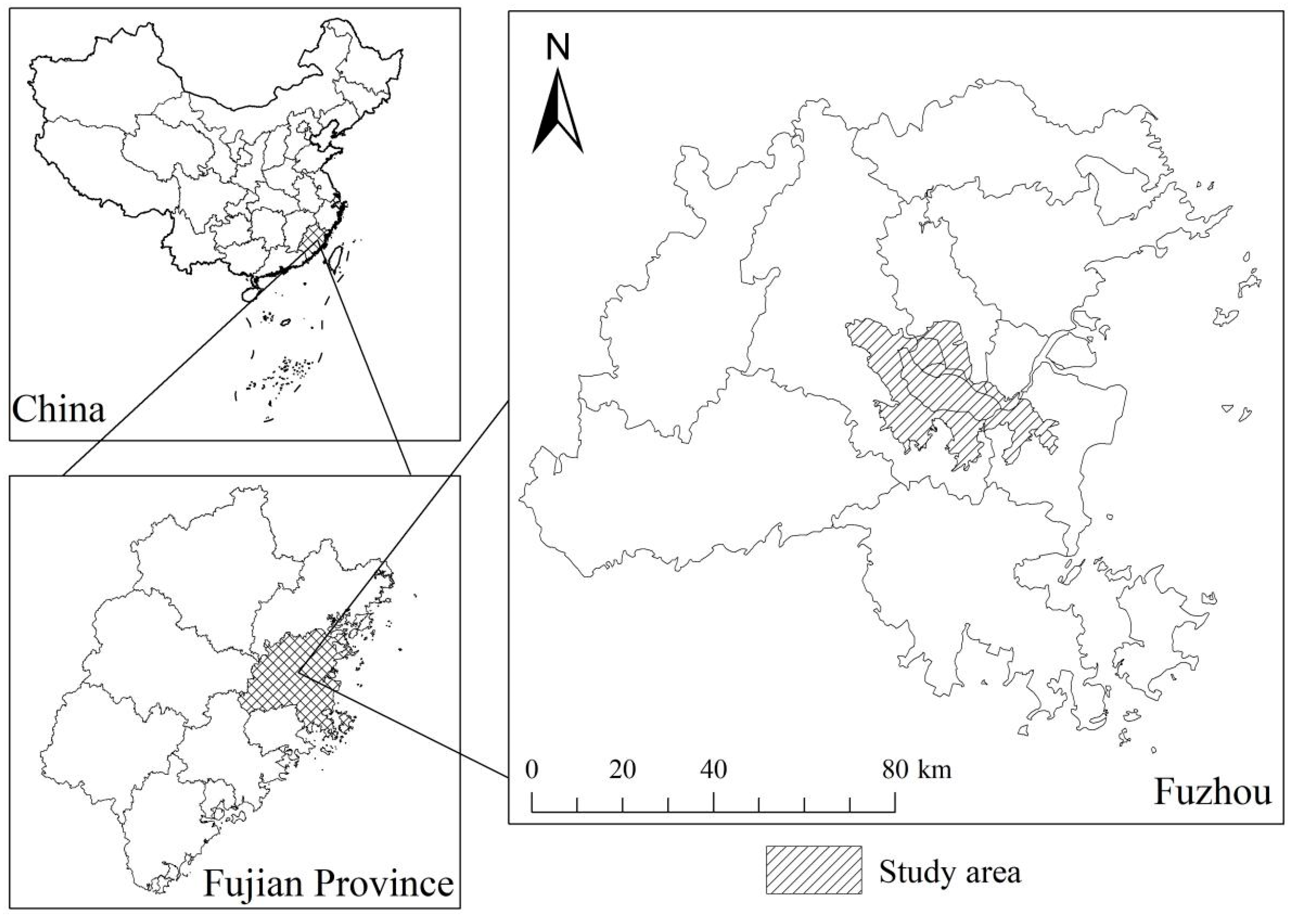
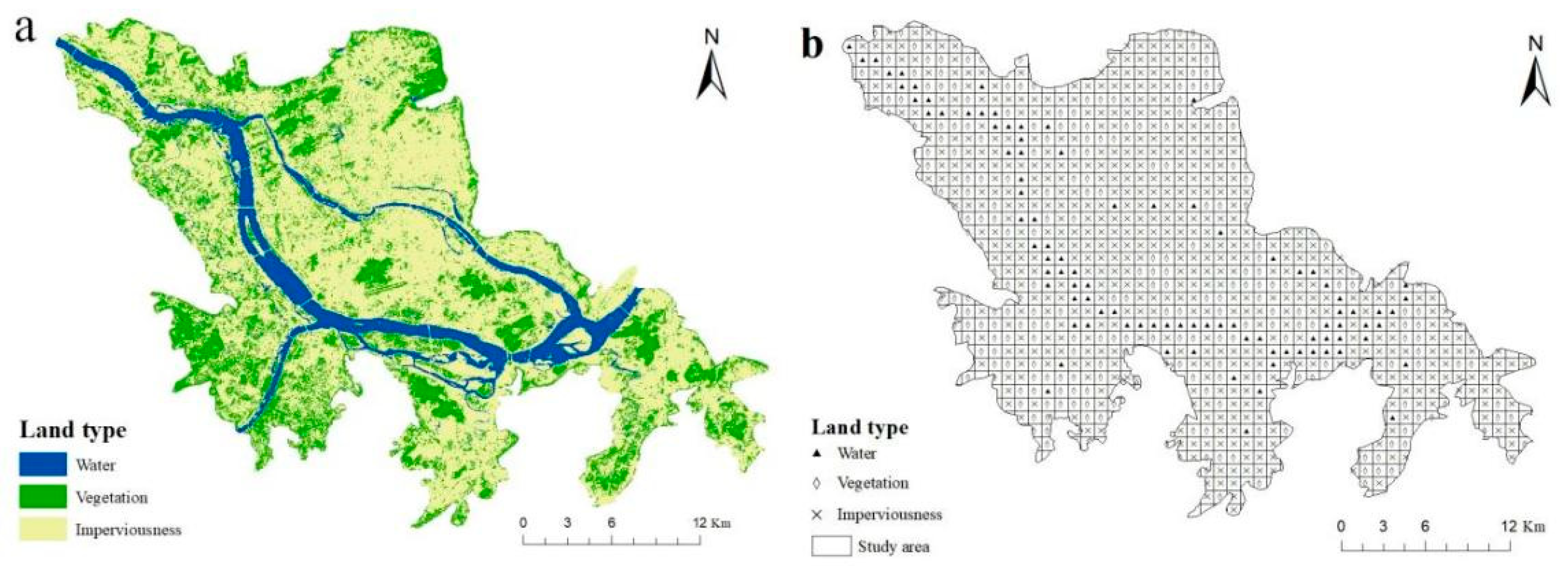
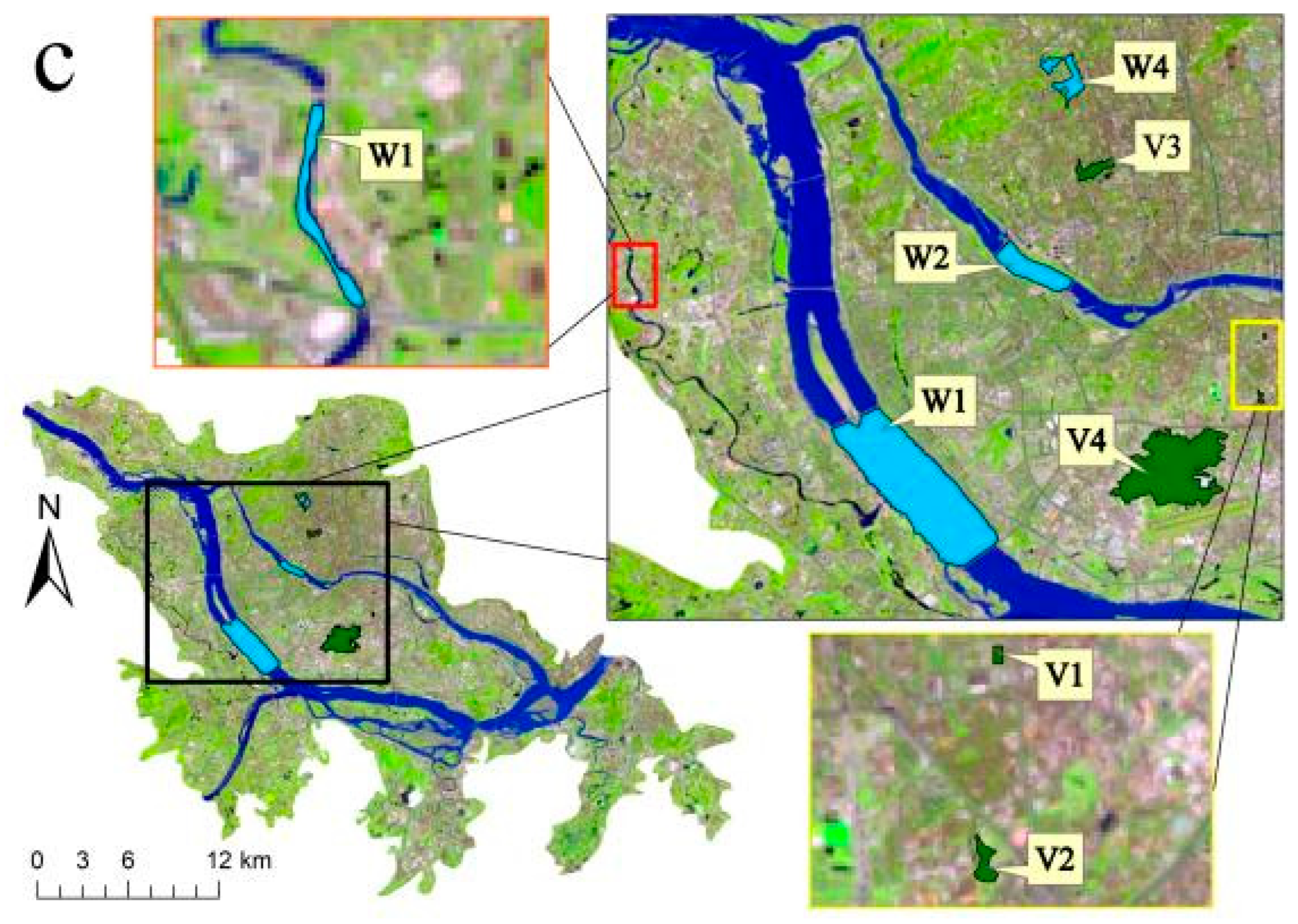
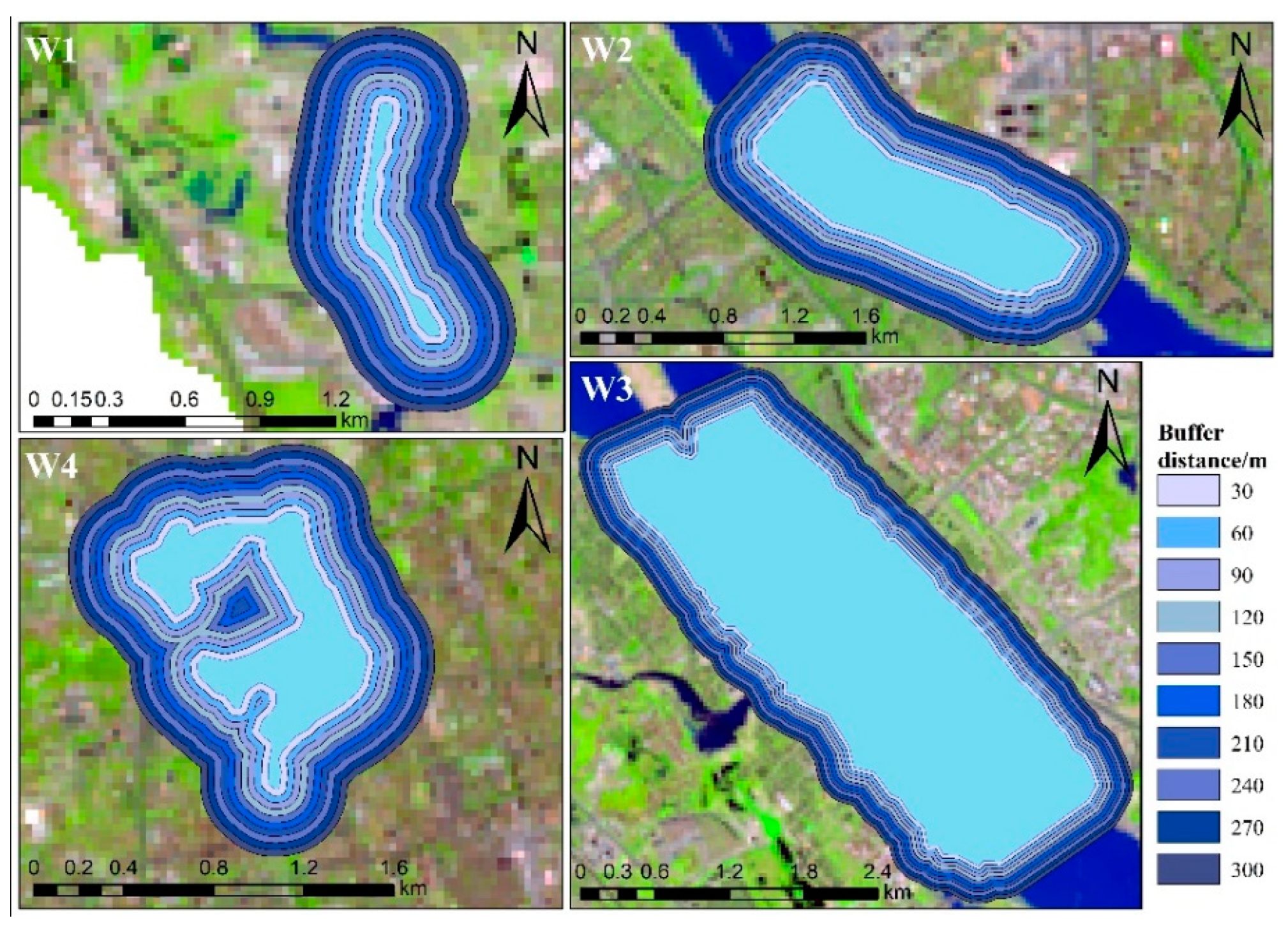
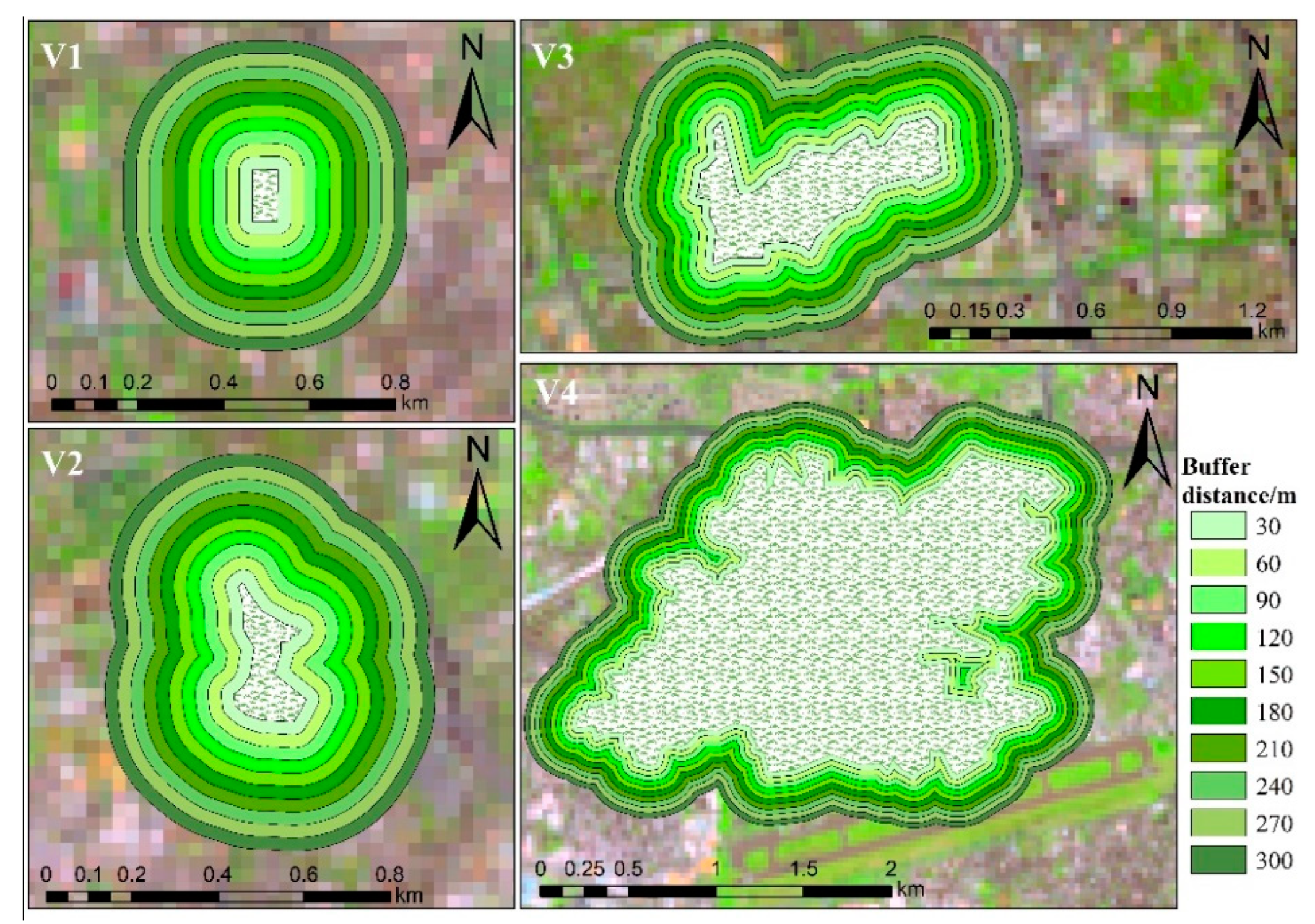
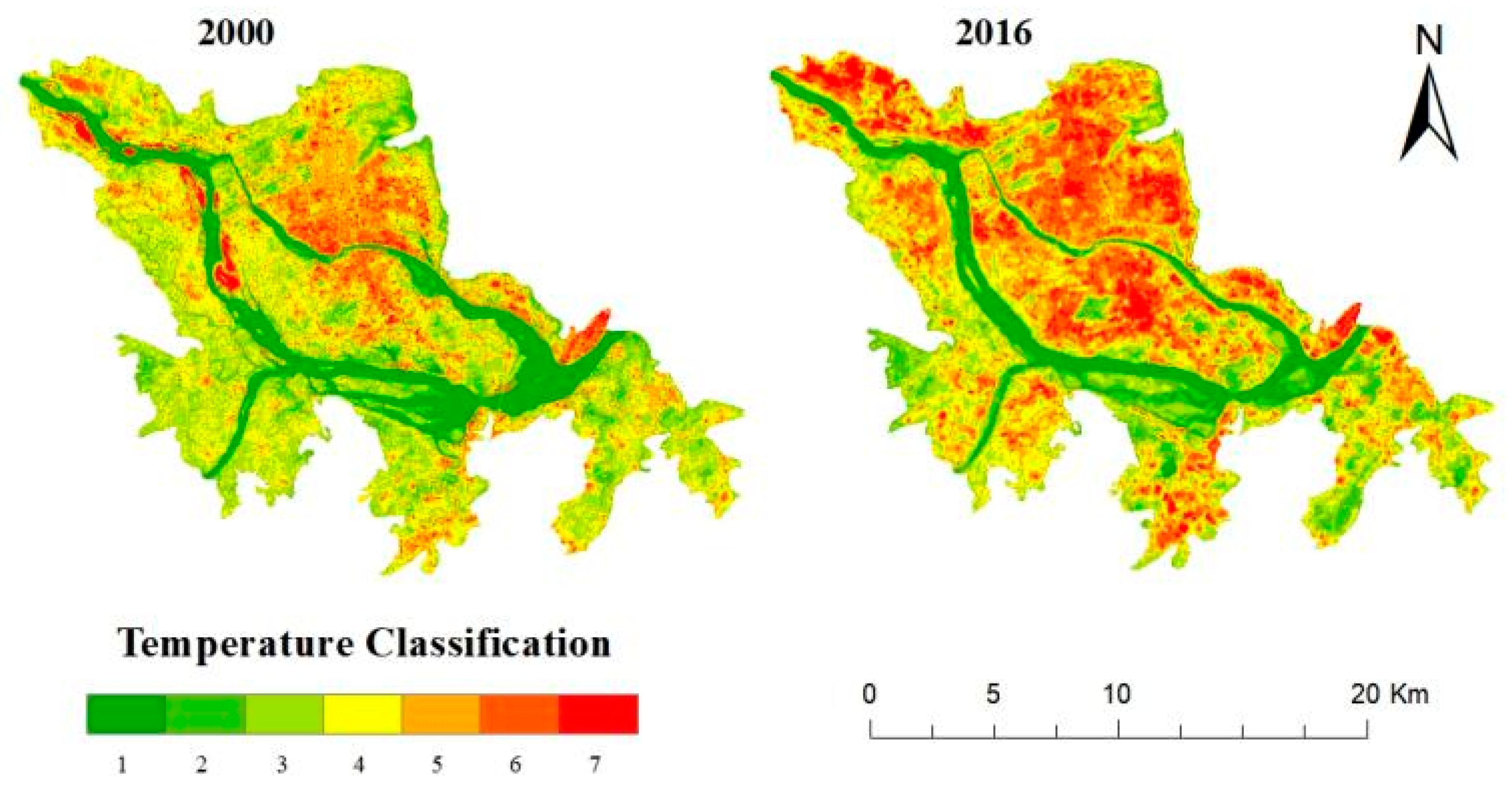
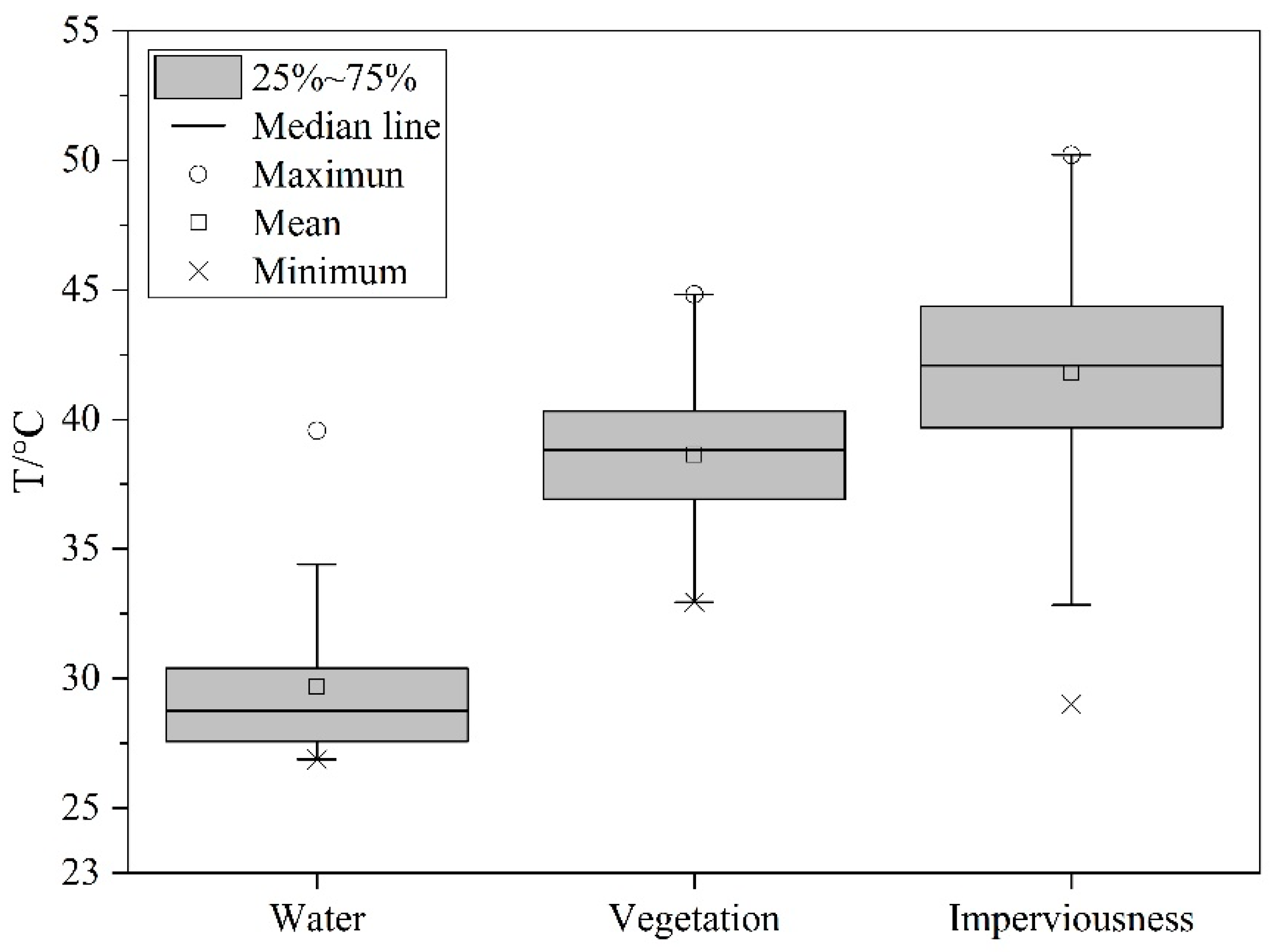

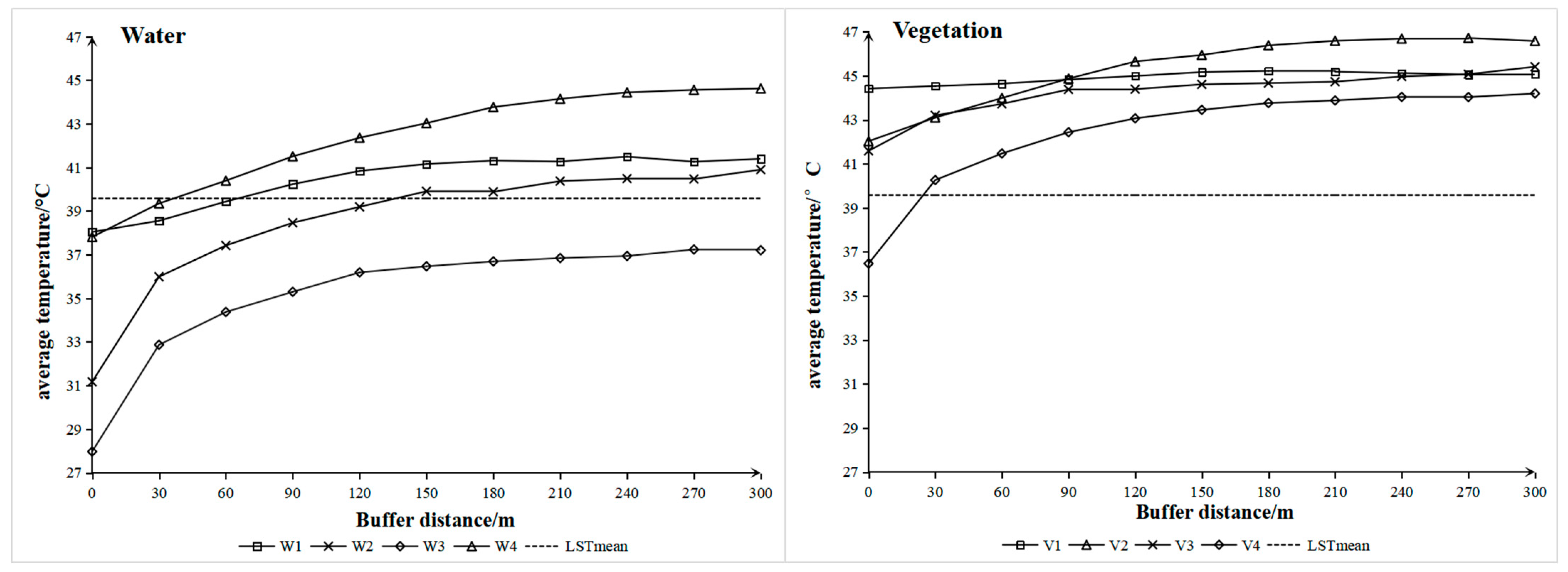
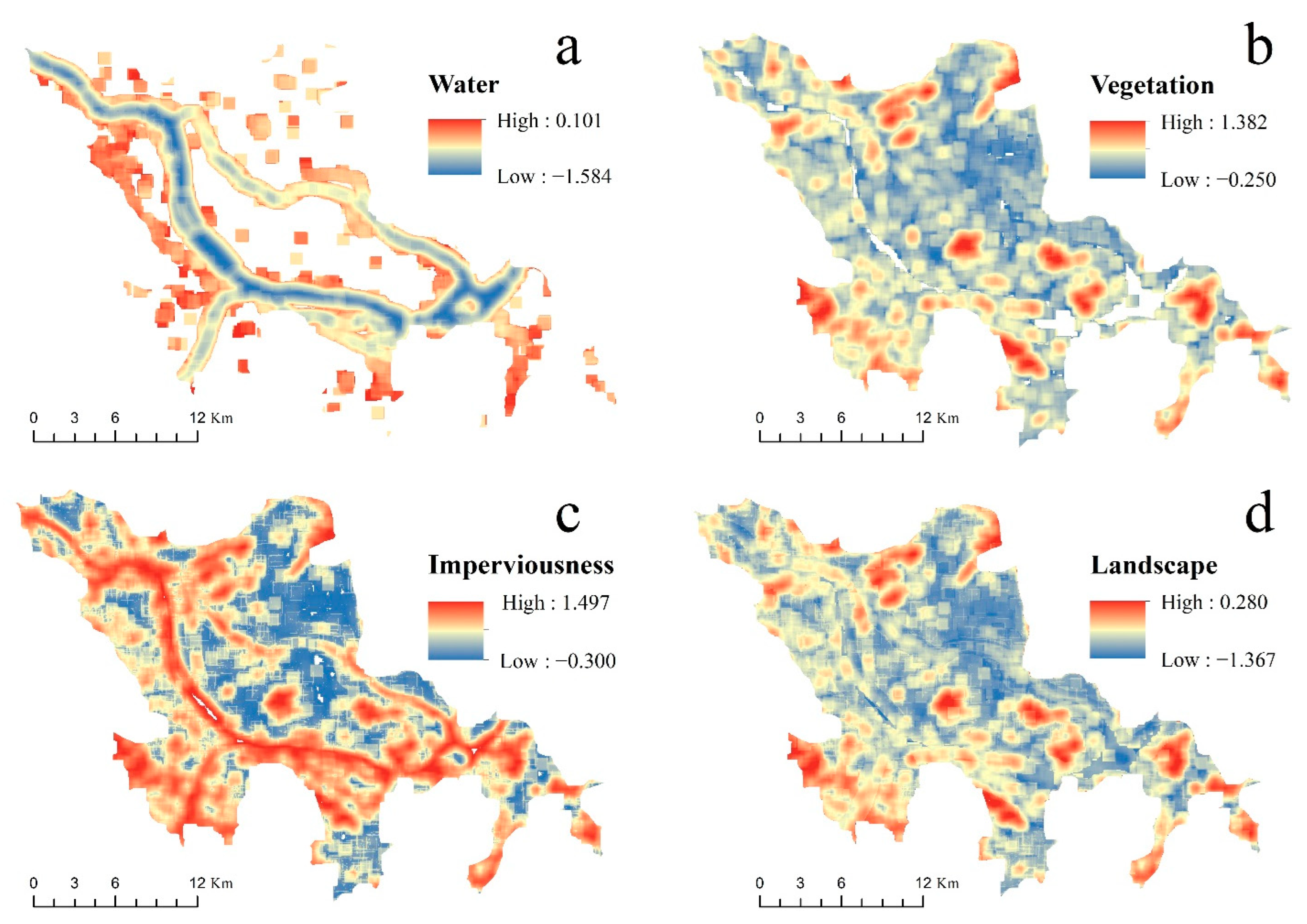

| Water | Vegetation | ||
|---|---|---|---|
| Number | Area/m2 | Number | Area/m2 |
| W1 | 47,141.8 | V1 | 7216.37 |
| W2 | 823,336 | V2 | 26,543.4 |
| W3 | 5,799,400 | V3 | 226,516 |
| W4 | 424,352 | V4 | 3,025,610 |
| Land Type | AI | Area_mn | LPI | PLAND | ||||||||||||||||||||
|---|---|---|---|---|---|---|---|---|---|---|---|---|---|---|---|---|---|---|---|---|---|---|---|---|
| Original | Normalized | Original | Normalized | Original | Normalized | Original | Normalized | |||||||||||||||||
| Max | Min | Mean | Max | Min | Mean | Max | Min | Mean | Max | Min | Mean | Max | Min | Mean | Max | Min | Mean | Max | Min | Mean | Max | Min | Mean | |
| Water | 99.61 | 0 | 78.88 | 1 | 0 | 0.80 | 86.49 | 0.09 | 11.85 | 1 | 0 | 0.14 | 100 | 0.10 | 19.31 | 1 | 0 | 0.19 | 100 | 0.10 | 20.98 | 1 | 0 | 0.21 |
| Vegetation | 99.61 | 0 | 67.69 | 1 | 0 | 0.68 | 85.79 | 0.09 | 3.30 | 1 | 0 | 0.04 | 99.53 | 0.10 | 15.97 | 1 | 0 | 0.16 | 99.58 | 0.10 | 23.81 | 1 | 0 | 0.24 |
| Imperviousness | 99.61 | 0 | 87.70 | 1 | 0 | 0.12 | 86.49 | 0.09 | 28.11 | 1 | 0 | 0.67 | 100 | 0.10 | 59.88 | 1 | 0 | 0.40 | 100 | 0.10 | 63.60 | 1 | 0 | 0.36 |
| Water | Vegetation | Imperviousness | ||||||||||
|---|---|---|---|---|---|---|---|---|---|---|---|---|
| PC1 | PC2 | PC3 | PC4 | PC1 | PC2 | PC3 | PC4 | PC1 | PC2 | PC3 | PC4 | |
| AI | −0.852 | −0.239 | −0.320 | −0.340 | 0.870 | 0.084 | 0.293 | 0.387 | 0.137 | 0.740 | 0.490 | 0.440 |
| Area_mn | −0.522 | 0.466 | 0.510 | 0.500 | 0.479 | −0.295 | −0.630 | −0.536 | 0.083 | −0.671 | 0.539 | 0.502 |
| LSI | 0.048 | 0.844 | −0.272 | −0.460 | 0.096 | 0.905 | 0.000 | −0.413 | −0.975 | 0.047 | 0.008 | 0.215 |
| Pland | −0.009 | 0.113 | −0.751 | 0.650 | 0.065 | −0.293 | 0.719 | −0.626 | 0.152 | 0.002 | −0.685 | 0.712 |
| Eigenvalue | 0.145 | 0.223 | 0.002 | 0 | 0.147 | 0.016 | 0.002 | 0 | 0.247 | 0.012 | 0.001 | 0 |
| Percent eigenvalue/% | 85.51 | 13.5 | 0.91 | 0.08 | 89.16 | 9.43 | 1.04 | 0.37 | 94.79 | 4.67 | 0.35 | 0.19 |
| PC1 | PC2 | PC3 | Weight | |
|---|---|---|---|---|
| WLCI | −0.656 | −0.686 | −0.316 | 0.292 |
| VLCI | −0.482 | 0.057 | 0.875 | 0.379 |
| ILCI | −0.582 | 0.726 | −0.368 | 0.329 |
| Eigenvalue | 0.175 | 0.038 | 0.003 | - |
| Percent eigenvalue/% | 80.91 | 17.76 | 1.33 | - |
| Temperature Classification | 2000 | 2016 | 2000–2016/% | |||
|---|---|---|---|---|---|---|
| Area/km2 | Proportion/% | Area/km2 | Proportion/% | |||
| 1 | Extra-low temperature | 89.748 | 12.856 | 62.554 | 8.960 | −3.896 |
| 2 | Low temperature | 73.776 | 10.568 | 70.676 | 10.124 | −0.444 |
| 3 | Sub-low temperature | 190.859 | 27.340 | 124.167 | 17.786 | −9.554 |
| 4 | Medium temperature | 184.433 | 26.419 | 147.522 | 21.132 | −5.287 |
| 5 | Sub-high temperature | 102.823 | 14.729 | 150.682 | 21.585 | 6.856 |
| 6 | High temperature | 45.590 | 6.531 | 106.387 | 15.240 | 8.709 |
| 7 | Extra-high temperature | 10.871 | 1.557 | 36.112 | 5.173 | 3.616 |
| Total | 698.100 | 100 | 698.100 | 100 | 0 | |
| Water | Vegetation | Imperviousness | |||||||||||||
|---|---|---|---|---|---|---|---|---|---|---|---|---|---|---|---|
| AI | Area_mn | LPI | PLAND | WLCI | AI | Area_mn | LPI | PLAND | VLCI | AI | Area_mn | LPI | PLAND | ILCI | |
| AI | 1 | 0.602 | 0.737 | 0.739 | −0.808 | 1 | 0.541 | 0.828 | 0.843 | 0.938 | 1 | 0.661 | 0.794 | 0.791 | −0.775 |
| Area_mn | 0.602 | 1 | 0.850 | 0.797 | −0.901 | 0.541 | 1 | 0.747 | 0.706 | 0.715 | 0.661 | 1 | 0.726 | 0.719 | −0.955 |
| LPI | 0.737 | 0.850 | 1 | 0.960 | −0.978 | 0.828 | 0.747 | 1 | 0.955 | 0.791 | 0.794 | 0.726 | 1 | 0.982 | −0.895 |
| PLAND | 0.739 | 0.797 | 0.960 | 1 | −0.963 | 0.843 | 0.706 | 0.955 | 1 | 0.968 | 0.791 | 0.719 | 0.982 | 1 | −0.890 |
| Mean | 0.693 | 0.750 | 0.850 | 0.832 | −0.913 | 0.737 | 0.665 | 0.843 | 0.834 | 0.896 | 0.749 | 0.702 | 0.746 | 0.831 | −0.879 |
| WLCI | VLCI | ILCI | LPCI | |
|---|---|---|---|---|
| WLCI | 1 | 0.249 | −0.425 | −0.202 |
| VLCI | 0.249 | 1 | 0.564 | −0.927 |
| ILCI | −0.425 | 0.564 | 1 | −0.759 |
| Mean | 0.337 | 0.407 | 0.495 | 0.629 |
Publisher’s Note: MDPI stays neutral with regard to jurisdictional claims in published maps and institutional affiliations. |
© 2022 by the authors. Licensee MDPI, Basel, Switzerland. This article is an open access article distributed under the terms and conditions of the Creative Commons Attribution (CC BY) license (https://creativecommons.org/licenses/by/4.0/).
Share and Cite
Liu, S.; Li, X.; Chen, L.; Zhao, Q.; Zhao, C.; Hu, X.; Li, J. A New Approach to Investigate the Spatially Heterogeneous in the Cooling Effects of Landscape Pattern. Land 2022, 11, 239. https://doi.org/10.3390/land11020239
Liu S, Li X, Chen L, Zhao Q, Zhao C, Hu X, Li J. A New Approach to Investigate the Spatially Heterogeneous in the Cooling Effects of Landscape Pattern. Land. 2022; 11(2):239. https://doi.org/10.3390/land11020239
Chicago/Turabian StyleLiu, Shuang, Xuefei Li, Long Chen, Qing Zhao, Chaohui Zhao, Xisheng Hu, and Jian Li. 2022. "A New Approach to Investigate the Spatially Heterogeneous in the Cooling Effects of Landscape Pattern" Land 11, no. 2: 239. https://doi.org/10.3390/land11020239
APA StyleLiu, S., Li, X., Chen, L., Zhao, Q., Zhao, C., Hu, X., & Li, J. (2022). A New Approach to Investigate the Spatially Heterogeneous in the Cooling Effects of Landscape Pattern. Land, 11(2), 239. https://doi.org/10.3390/land11020239






